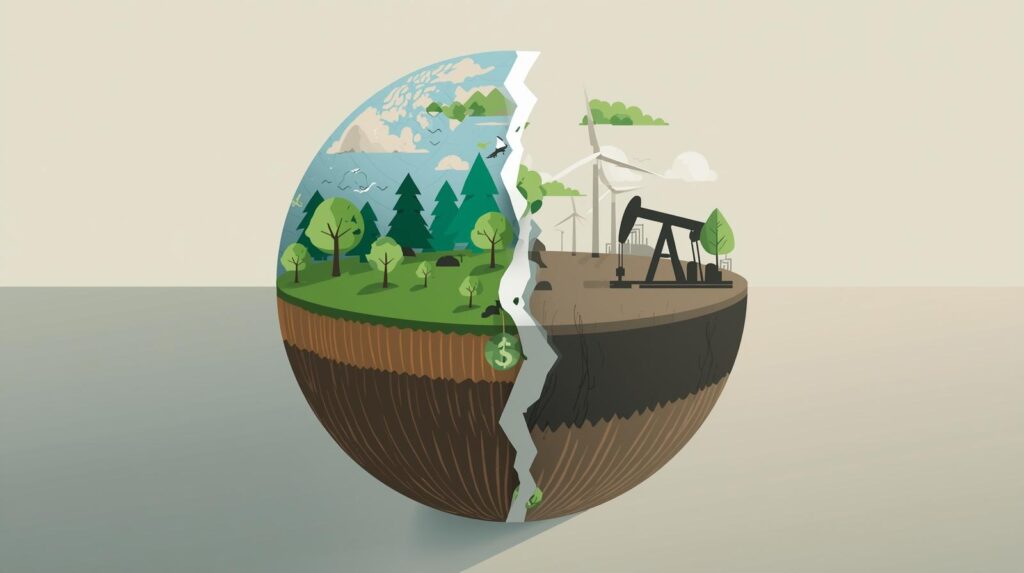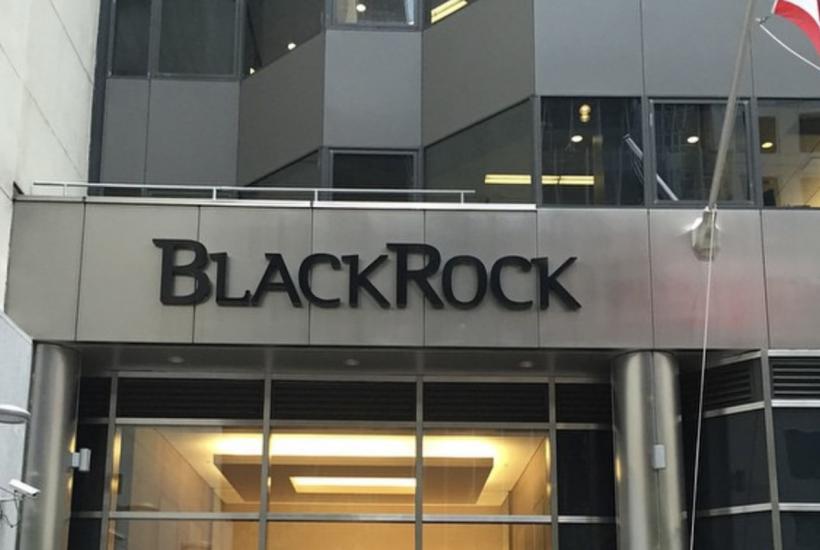This article is reprinted with permission from Voxeurop.
A massive greenwashing operation is quietly unfolding across Europe, affecting thousands of investors who believe they are supporting climate-friendly initiatives. These investors have bought “green-labelled” bonds issued by Eni, Italy‘s largest – and the world’s 13th largest – fossil fuel company. The problem is that these bonds may well be funding carbon-emitting activities, undermining the very energy transition and climate goals that Eni claims to support. As the activist group Reclaim Finance describes the scam: “the bond market has become a safe haven for easy access to fossil fuel finance.”
Eni’s CEO Claudio Descalzi has persuaded thousands of investors across Europe to back a sustainability strategy that can be summed up as: Give me your money to mitigate climate change, and then I’ll decide how much of it goes towards exacerbating climate change.

“The energy transition is irreversible,” Descalzi said on a well-known Sunday talk show on the Italian public broadcaster in June, laying out his plan. “But the money has to come from private capital. When you set targets, you have to provide the opportunity for each industrial activity to be optimised with the tools to achieve those targets, and to do so freely.”
The fact remains that both private and institutional investors have signed what are effectively Eni “blank climate cheques”. Meanwhile Descalzi earns a staggering €1.6 million a year, and has been at the helm of the state-controlled company over a decade and through four different Italian governments.
The controversial bonds
The type of financial product issued by Eni is called a “Sustainability-Linked Bond” (SLB). Eni has been promoting such “green-labelled” financial products in several European countries. This plan was backed by the Italian ministry of economy and finance, which owns more than 30 percent of the company’s shares, and a coalition of banks that marketed the bonds while downplaying experts’ warnings about their true environmental impact.
These products are designed to attract investors who are concerned about the environment. But there is growing concern that the money raised by these bonds could end up further funding fossil fuel activities rather than helping the environment. There is nothing to stop Eni from doing so, and the company has vowed to increase its production of oil and natural gas in years to come.
In January 2023, Eni issued one of its most controversial SLBs, aimed at climate-conscious retail investors in Italy. The bond was initially valued at €1 billion, but was so popular that it quickly doubled to €2 billion.
The success of these bonds was boosted by the rather enthusiastic attitude of the Italian mainstream media, which reported ENI’s statements without questioning its weak commitments to reduce carbon emissions.
The reality is that investors in these bonds are unlikely to make a significant contribution to reducing greenhouse gas (GHG) emissions. Eni’s plans for the money raised by these bonds are likely to support its usual business activities, leaving most of its emissions untouched.
The shortcomings of the bond, involving major public, industrial and financial powers, were also recently exposed in a report published in July by the Anthropocene Fixed Income Institute (AFII), a UK-based NGO that helps investors direct capital into impactful sustainable investments “in the age of human induced climate change”
This situation highlights the need for greater clarity and honesty in the way financial products are marketed to the public. A first step in this direction is expected when the European Union’s new regulation on green bonds comes into force on 21 December this year (1).
Big polluters rely on industry self-regulation of eco-bonds
In recent years, SLBs have become popular with companies as a way of raising fresh funds to support their efforts to combat global warming.
But as our research shows, these bonds are not as “green” as they seem. Like traditional green bonds, SLBs are based on voluntary standards. The main difference is that while the former require the issuer to use the money for specific environmental projects, SLBs only require companies to meet certain sustainability targets, known as Key Performance Indicators (KPIs). This means that money raised through SLBs can be used for any purpose, including activities that could harm the environment, as long as the company meets its KPIs.
More specifically, the Italian fossil fuel company’s SLBs are linked to two key KPIs listed in the issuance prospectus: increasing renewable energy capacity by 5 gigawatts (GW), and reducing greenhouse gas emissions from its operations by 65% compared to 2018 levels.
Bonds classified as ESG (promoting “environmental, social and governance” benefits) include not only SLBs but also the more aptly named “green” and “sustainability” (as well as “social”) bonds. The ESG bond market operates under voluntary guidelines set by the International Capital Market Association (ICMA), a trade association that includes the companies that issue the bonds, the agencies that certify them and the banks that market them to investors (2). This means that the same actors who benefit from these bonds also set the rules and ensure compliance, creating a conflict of interest.
The ESG bond market is not regulated by any public authority, so there is little oversight to ensure that these bonds actually contribute to environmental sustainability. In Italy, for example, Consob, the national financial markets regulator, simply approved Eni’s SLBs on the basis of general rules for financial products, without examining their environmental merits.
No wonder SLBs are the preferred debt financing instrument of fossil energy companies among all ESG-qualified companies. Data from the London Stock Exchange Group, used for our analysis, shows that between 2021 and 2023 some oil and gas multinationals have raised around €9 billion through SLBs. The fossil fuel issuers are Repsol (Spain), Gasunie (Netherlands), Odfjell (Norway), Orlen (Poland), SFL Corporation (Bermuda), Eni and Snam (Italy).https://datawrapper.dwcdn.net/0UA29/9/
Misinformation greened Eni’s carbon-sponsoring bonds
ENI raised €4.75 billion through four different SLB issues between June 2021 and September 2023, making it the largest issuer of SLBs in the fossil fuel sector. These bonds were marketed mainly in Italy, France, Germany, the UK and Switzerland, between June 2021 and September 2023, with the help of major banks (3).
Both Intesa Sanpaolo (which is an ENI shareholder both directly and indirectly through the green funds marketed by its asset management arm Eurizon), and UniCredit coordinated the consortium of banks that commercialised the €2 billion SLB reserved for Italian retail investors in January 2023. The group also includes Banca Akros, BPER Banca, BNP Paribas and Crédit Agricole CIB (the latter two banks announced last May that they have retreated from oil and gas bond deals).
In Italy, 310,000 retail investors bought €600 million worth of bonds in the January 2023 issue, attracted by the high fixed rate of 4.3 percent, which was more appealing than returns on conventional bonds.
Eni’s CEO continued to publicly laud the success of the “greened” bonds. “So many Italians have believed in what we are doing, both in terms of progressive evolution towards decarbonised industrial processes and products, and in terms of guaranteeing energy security,” commented Claudio Descalzi at the launch of the Italian bond, which was admitted to trading on the Milan Stock Exchange in February 2023.
ENI’s board decided to issue the SLBs without the prior approval of the company’s shareholders, as the Italian ministry of economy and finance confirmed to Voxeurop. The ministry also sits on the board and is therefore co-responsible for any decision, but refused to explain if and why its representatives formally voted in favour of the issue.
The Italian mainstream media played an important role in “greening” Eni’s SLBs by giving them favourable coverage. Major newspapers such as La Repubblica and La Stampa respectively described the bonds as “sustainable” and “green” – two categories of ESG bonds that have to meet much stricter criteria than the SLBs.
As explained, unlike “green and “sustainable” bonds, SLBs have no requirement to use the proceeds for specific 100 percent environmental projects, allowing Eni to use the money for general purposes, including fossil fuel production (4). This is confirmed by the prospectus which is the public information document that Eni provided to investors, indicating the characteristics of the SLB and the targets to be achieved (the above-mentioned KPIs ). Unicredit clarified to Voxeurop that indeed Eni’s issuance “was not conceived of as a ‘Green Bond’”.
Josephine Richardson, managing director and head of research at AFII, explains that essentially, as an SLB issuer, Eni enjoys a great deal of flexibility and is entitled to use investors’ money for its fossil fuel production, as long as it meets the two sustainability targets or KPIs that it has committed to in its prospectus. “Both refinancing of debt originally used for oil exploration and expenditure strictly related to oil production could theoretically be covered,” she said.
Eni green bonds will trigger weak GHG reduction
Taking advantage of the laxity of the SLB requirements, Eni arbitrarily set poor climate targets. Firstly, it committed to reducing a negligible proportion of its total greenhouse gas emissions. Secondly, instead of substantially reducing this amount of emissions, the Italian oil major decided to largely offset it with reductions achieved elsewhere by buying carbon credits generated by third-party projects (reforestation or renewable energy). The latter is a cheap way for large emitters to reduce their carbon footprint.
These flaws – unheeded by the Italian government – have been pointed out by independent organisations, banks, and media. The first criticism came from Moody’s, one of the world’s leading rating agencies, which certified Eni’s “Sustainability-Linked Financing Framework” (a non-binding document, unlike the prospectus, which sets out the company’s actual commitments) (5).
In its assessment (technically called “second party opinion”) of Eni’s framework, Moody’s said that Eni’s SLBs have a “limited overall contribution” to sustainability. This is because the company has committed in its framework to invest the money borrowed from bondholders to reduce only its direct emissions (oil and gas production and refining) and those associated with its energy consumption. Together, these two categories of emissions (classified as Scope 1 and 2, respectively) represent no more than 3 percent of Eni’s total emissions, according to Moody’s.
The reduction of Eni’s indirect emissions from upstream suppliers and downstream customers (Scope 3) is excluded from the SLB targets. However, such emissions, especially those from companies that purchase and burn fossil fuels for their operations (e.g. industrial plants and airlines), account for the largest volume of GHGs attributed to fossil fuel suppliers such as Eni.
“Also including the emissions generated by the company’s suppliers and customers (Scope 3) would have been the opportunity for an impactful sustainability-linked bond,” said Richardson of AFII. “I hope investors will realise this is not a very impactful sustainability-linked bond and make consequent choices.”
An Eni spokesperson provided an explanation that seems contradictory, pointing out that the four sustainability-linked bonds “have maturities [i.e. the payback deadline] between 2027 and 2030″. They said that these were years “in which it will not be possible to determine whether or not the Scope 3 target will be reached – this will only be known in the first part of 2031. It was therefore not possible to include this target in the bonds.”
Yet Eni is not even sure that it will achieve the Scope 1 and 2 reductions promised to bondholders. In fact, if it fails to meet these targets, Eni will have to pay investors a higher interest rate of 4.8 percent as a sort of penalty (i.e., 25 percentage points more than what is usually included in the prospectus of SLB issuers). However, this penalty is small compared to the potential impact of the environmental damage (6).
“We are still waiting for a publicly agreed methodology to be defined on Scope 3 emissions,” added Eni’s spokesperson. In reality, such methodology has already been agreed at an EU level and should kick in by 2025 (7).
Moody’s states that Eni’s approach is “at odds with the recommendations of the International Energy Agency (IEA) and Intergovernmental Panel on Climate Change (IPCC), which emphasize the need for immediate action to reduce all greenhouse gas emissions (Scopes 1, 2, and 3) to achieve the 1.5°C objective of the Paris Agreement”.
Despite its criticism, Moody’s has put its green stamp on the company’s framework, confirming compliance with the International Capital Market Association standards. Before issuing the SLB, Eni did not ask Moody’s to also assess the product prospectus, which formalized the company’s weak commitments. Moody’s, which Eni paid for its so-called “independent” certification (issuers always pay assessors), declined to comment.
Most of the time, assessors’ (or second-party opinion providers) reviews are “based on the pre-issuance documents such as the SLB Framework, and not on a Bond-by-Bond basis,” said the International Capital Market Association’s spokesperson. “This is clearly the issuers’ decision. There is no rule preventing that practice.”
Richardson said that it is “generally acknowledged to be non-ideal that SPO providers assess financing frameworks rather than bonds”.
Intesa Sanpaolo insisted that Eni’s framework “has been externally certified as sustainable” and therefore “has been classified as meeting the needs of subscribers who have indicated their preferences for sustainable investments” (8). Nonetheless, the lack of transparency on the part of Intesa Sanpaolo and Eni raises questions about the ability of investors to make an informed decision when purchasing the bond (9). It is worth noting that Intesa Sanpaolo, Unicredit and all the underwriters except BPER, together with Eni and Moody’s, are on the ICMA member list, working together side by side for the same “cause”.
Over-flexibility may further water down Eni climate efforts
As highlighted in the recent AFII report, which assessed 19 SLBs issued by companies in different sectors, Eni’s bond is also questionable because the company intends to neutralise 40 percent of its cope 1 and 2 emissions through the use of offsets (or carbon credits). Compensating for emissions rather than reducing them slows down the transition to renewables and the decarbonisation process. Eni’s offsets “are reported to be 5.9mt CO2 equivalent for 2023”.
In its 2023 report the Climate Bond Initiative (CBI), the world’s largest certification platform for the financing of sustainable projects, also criticised Eni’s SLB, stating that the company should “set more ambitious reduction targets that are in line with the industry’s path and do not include offsets”. Eni’s plan “is dependent on offsets, Ccs (for CO2 capture and storage) projects and the expansion of the gas business […] which will not address the radical turnaround that is needed,” the CBI researchers wrote in their report.
AFII gives Eni a fair 50/50 chance of meeting its SLB targets, and says that this probability of success depends on the company’s planned use of carbon offsets. According to the same report: “A simple extrapolation of the recent trend of Eni’s SLB would suggest the target will narrowly be missed […], however […] offset purchases significantly increase the chance of achieving the target”.
Richardson of AFII argued: “Should Eni just pay to buy some more offsets so it can meet its targets and no longer have to pay their step up on coupon (i.e. higher interest rate to investors)? That is clearly not the best use of a Sustainability Linked Bond.”
All in all, Eni’s SLB does not effectively help to keep the company on track towards its carbon neutrality target in 2050 (10).
AFII’s analysis of SLBs issued by other fossil energy companies revealed similar problems to those highlighted in relation to Eni’s SLB (11).
“Some SLBs issuers had too much flexibility with the use of SLBs prior to setting up a credible transition plan,” Matthew MacGeoch, Senior Research Analyst at CBI, told Voxeurop, implicitly referring to Eni. “However, recent trends show a convergence towards the use of credible GHG decarbonisation targets (all material sources of emission, and no abuse of offsets).”
Richardson shares MacGeoch’s optimistic views: “We are very much in favour of this kind of product because we believe it has great potential for impact,” she said, “although not all those that have been launched so far have necessarily had an impact, nor have they all set high standards or concrete goals.”
Stefano Valentino is a Bertha Challenge Fellow 2024. Giorgio Michalopoulos is a freelance journalist. This article is part of the investigation coordinated by Voxeurop with the support of the Bertha Challenge fellow.
Footnotes
1) The new regulations mentions as follows: “To be able to use the designation European green bond or EuGB, issuers: must invest the proceeds from these bonds in full, before the bond reaches maturity, in sustainable economic activities covered by the European Union’s (EU) taxonomy* legislation (Regulation (EU) 2020/852 – see summary). These include fixed assets, capital and operating expenditures, and assets and expenditure of households (this is known as the gradual approach).”
2) ICMA requires that one of its approved external reviewers evaluate the ESG bond before issuance to certify that the product meets its guidelines (through a specific assessment form).
3) Eni’s SLBs: 7 June 2021, 23 January 2023, 15 May 2023, 7 September 2023.
4) The prospectus (the public information document) that Eni provided to investors confirms that: “The bonds are not marketed as so-called green bonds because the Issuer expects to use the net proceeds thereof for general corporate purposes and does not intend to use the net proceeds for projects or business activities that meet environmental or sustainability criteria”. The same disclaimer is replicated in the prospectus of the other SLBs issued by Eni both in Italy and abroad.
5) Generally, while the framework sets the company’s overall sustainability goals, the specific targets that the issuer intends to meet as a counterpart of the funding cashed from bondholders are outlined in the information document (prospectus) provided at each issuance. Albeit setting ambitious targets to reduce the overall value chain emissions in the long term, Eni’s framework clarifies that the company will use the SLBs proceeds to reduce, exclusively, its Scope 1 and 2 emissions in the short term.
6) This is precisely what happened to the Italian utility Enel (also partially owned by the Italian government), the first company to launch an SLB with a record value of €15 billion raised between 2019 and 2023. Josephine Richardson, managing director and head of research at AFII, recalls that Enel did not meet its sustainability promises in 2023. As a result, it will have to pay bondholders a slightly higher interest rate.
7) Harmonised EU criteria for quantifying and disclosing carbon emissions and reduction targets as well as other environmental and social targets will come into force in 2025 under the new Corporate Sustainability Disclosure Directive (CSRD). Companies will have to comply with the CRSD obligations through a set of specific European sustainability reporting standards (ESRS). The standard covering climate change makes reference to a well defined methodology to calculate Scope 3 emissions.
8) Full response by Intesa Sanpaolo, in Italian: ‘Intesa Sanpaolo e Unicredit sono state Responsabili del Collocamento dell’emissione obbligazionaria Eni Sustainability-Linked 2023/2028 la cui offerta si è aperta il 16 gennaio 2023 e conclusa il 20 gennaio 2023, del quale hanno fatto parte anche Banca Akros, BNP Paribas, BPER Banca e Crédit Agricole CIB, in qualità di Collocatori e Garanti unitamente ai Responsabili del Collocamento. Come indicato nel prospetto, il bond basa la caratteristica di sostenibilità sulla capacità dell’emittente (ENI) di osservare determinati parametri ESG durante la vita dell’obbligazione stessa.Il Framework (Sustainability Linked Financing Framework) di Eni, a cui l’emissione oggetto della Vostra richiesta fa riferimento, è stato esternamente certificato come “SOSTENIBILE” da Agenzie specializzate indipendenti dalla società medesima e dai Collocatori (‘Second party opinion providers’) e rispetta i requisiti previsti dai Sustainability-Linked Bond Principles dell’ ICMA (International Capital Market Association). In virtù di quanto sopra è stata classificata come rispondente alle esigenze dei sottoscrittori che hanno segnalato le loro preferenze per investimenti sostenibili; l’emissione non è stata mai certificata, ne pensata o predisposta, come “GREEN BOND”.’
9) In its announcement, the Italian bank briefly mentioned the SLB framework and referred, for further information, to Eni’s “Investors” web page. Only by scrolling down the page, can users find the company press release. However, it does not explain what Scope 1 and 2 emissions mean, does not quantify the expected GHG reduction associated with the SLB, and does not provide neither a summary nor even a link to the prospectus (which includes Moody’s Second Party Opinion). This lack of transparency and missing information undermines the retail investors who do not have sufficient knowledge to find out how their money is actually being used, and understand whether Eni’s product meets their true preferences for sustainable investments (or not).
10) Contrary to the IEA and IPCC recommendations, the climate performance achieved by Eni through the proceeds of the SLBs in the short term represents just a tiny fraction of the GHG reduction (including Scopes 1, 2 and 3) projected by the company to meet its net zero target in 2050. “High-quality carbon credits, […] generated under stringent environmental and social constraints, will account for about 5% of the overall reduction in Scope 1+2+3 emissions by 2050,” said an Eni spokesperson, while avoiding comment on the use of offsets to meet the specific SLB targets. “Our strategy does not depend on carbon offsets, but [we] will resort to them where it is not possible to abate residual emissions, i.e. those that cannot yet be reduced due to technological and/or economic constraints.”
(11) Read further reports from the Anthropocene Fixed Income Institute (AFII), a UK-based NGO, on other companies, including SLBs: Orlen, SNAM and Repsol, amongst others.
Subscribe to our newsletter
Stay up to date with DeSmog news and alerts






